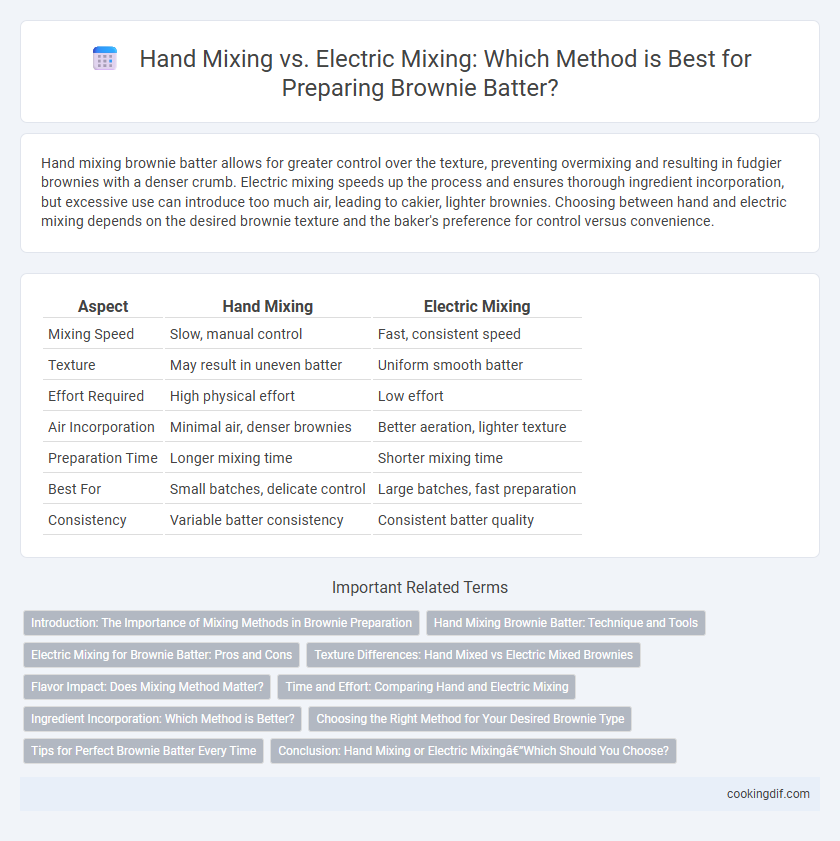Hand mixing brownie batter allows for greater control over the texture, preventing overmixing and resulting in fudgier brownies with a denser crumb. Electric mixing speeds up the process and ensures thorough ingredient incorporation, but excessive use can introduce too much air, leading to cakier, lighter brownies. Choosing between hand and electric mixing depends on the desired brownie texture and the baker's preference for control versus convenience.
Table of Comparison
| Aspect | Hand Mixing | Electric Mixing |
|---|---|---|
| Mixing Speed | Slow, manual control | Fast, consistent speed |
| Texture | May result in uneven batter | Uniform smooth batter |
| Effort Required | High physical effort | Low effort |
| Air Incorporation | Minimal air, denser brownies | Better aeration, lighter texture |
| Preparation Time | Longer mixing time | Shorter mixing time |
| Best For | Small batches, delicate control | Large batches, fast preparation |
| Consistency | Variable batter consistency | Consistent batter quality |
Introduction: The Importance of Mixing Methods in Brownie Preparation
Hand mixing preserves the dense and fudgy texture of brownies by preventing over-aeration of the batter, which can occur with electric mixers. Electric mixing introduces more air, resulting in a lighter and cakier brownie consistency preferred by some but less traditional. Choosing the right mixing method directly influences the final texture and richness characteristic of classic brownies.
Hand Mixing Brownie Batter: Technique and Tools
Hand mixing brownie batter requires a sturdy wooden spoon or silicone spatula to achieve the ideal dense and fudgy texture by gently folding ingredients without over-aeration. Proper technique involves slow, circular motions combined with occasional scraping of bowl edges to ensure even incorporation of cocoa powder and flour. This method prevents overmixing, which can lead to a tough crumb, maintaining the signature rich consistency of classic brownies.
Electric Mixing for Brownie Batter: Pros and Cons
Electric mixing for brownie batter ensures consistent texture and thorough ingredient incorporation, reducing preparation time significantly compared to hand mixing. It effectively aerates the batter, which can lead to a lighter, more uniform bake, but overmixing risks developing gluten and resulting in a denser, less fudgy brownie. While electric mixers offer convenience and efficiency, careful monitoring is essential to maintain the ideal brownie texture.
Texture Differences: Hand Mixed vs Electric Mixed Brownies
Hand mixing brownie batter typically results in a denser, fudgier texture due to the gentler incorporation of ingredients, preserving small pockets of air. Electric mixing aerates the batter more thoroughly, producing lighter, cakier brownies with a more uniform crumb structure. Overmixing with an electric mixer can lead to tougher brownies as gluten develops excessively, whereas hand mixing offers greater control over texture consistency.
Flavor Impact: Does Mixing Method Matter?
Hand mixing brownie batter preserves the rich, fudgy texture by gently incorporating ingredients without over-aerating, enhancing the deep chocolate flavor. Electric mixing can introduce excess air, resulting in a lighter, cakier texture that may dilute the intense taste. Choosing hand mixing ensures optimal flavor concentration and a denser, more indulgent brownie.
Time and Effort: Comparing Hand and Electric Mixing
Hand mixing brownie batter requires more physical effort and time, typically taking around 5 to 7 minutes to achieve a smooth consistency. Electric mixers significantly reduce preparation time to about 2 to 3 minutes, efficiently blending ingredients with minimal manual exertion. Choosing electric mixing enhances productivity and ensures a more uniform batter texture for optimal brownie quality.
Ingredient Incorporation: Which Method is Better?
Hand mixing ensures gentle incorporation of ingredients, preserving the delicate crumb and preventing over-aeration in brownie batter. Electric mixing offers faster blending but risks overmixing, leading to a tough texture by developing excess gluten. For optimal ingredient incorporation and a fudgy brownie, hand mixing is generally preferred.
Choosing the Right Method for Your Desired Brownie Type
Hand mixing brownie batter offers greater control over texture, making it ideal for fudgy, dense brownies where minimal air incorporation is desired. Electric mixing achieves a lighter, more aerated batter, perfect for cakier brownies with a fluffier crumb. Selecting the right method depends on whether you want a chewy, rich brownie or a soft, airy treat.
Tips for Perfect Brownie Batter Every Time
Hand mixing brownie batter ensures better control over texture, preventing overmixing that can lead to tough, dense brownies. Electric mixers speed up preparation but risk incorporating excess air, resulting in cakier brownies instead of fudgy ones. For perfect brownie batter every time, gently fold ingredients by hand until just combined, avoiding overbeating to maintain optimal moisture and tenderness.
Conclusion: Hand Mixing or Electric Mixing—Which Should You Choose?
Hand mixing brownie batter offers greater control over texture, reducing the risk of overmixing and resulting in a denser, fudgier bite. Electric mixing provides efficiency and consistency, ideal for quick preparation but may incorporate excess air, leading to a cakier brownie. Choosing hand mixing or electric mixing depends on desired brownie texture and preparation time preferences.
Hand mixing vs Electric mixing for brownie batter preparation Infographic

 cookingdif.com
cookingdif.com